Four of the Area’s Top Builders Compare Experiences
By Ann Zimmerman
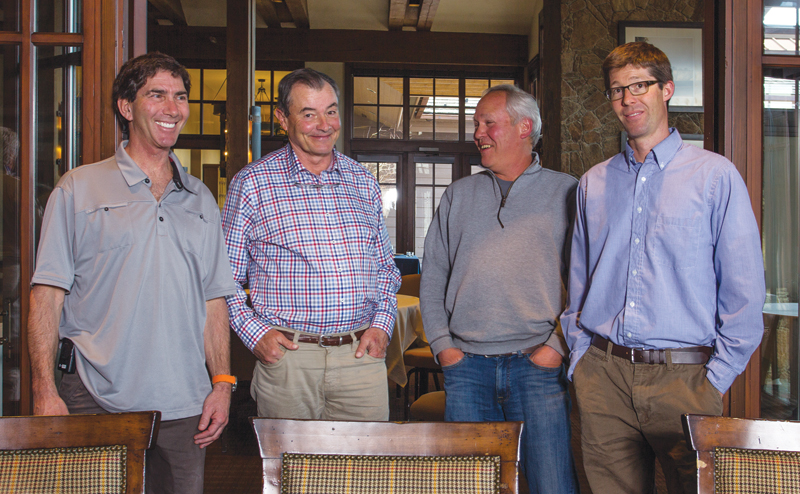
Finally, with the economic downturn in the rearview mirror and home construction on the rise, things are looking rosier for luxury homes. To reflect on where the industry has been and where it is now, four of the area’s most respected builders met in the timber and glass bar at Valley Club looking out to the tee and a tricky water hazard. Participants Dennis Kavanagh, David Lloyd, Craig Johnson, and Brian Poster sat together to converse on a spring afternoon for the first builders round table ever convened by Western Home Journal. Joining them from Western Home Journal were Dan Willett, Randy Schaeffer, Thatcher Marsted, and moderator.
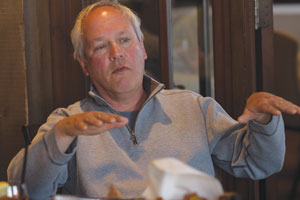
“For me, by building both contemporary and rustic styles and mastering both styles, I have found a crossover that has brought more refinement to rustic and a more naturalistic feel to contemporary.”
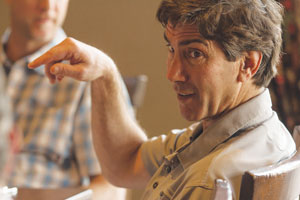
“Prices have increased for drywall and lumber. We are looking at newer materials to the market with more stable prices, and I would say the use of new types of material is up from the downturn.”
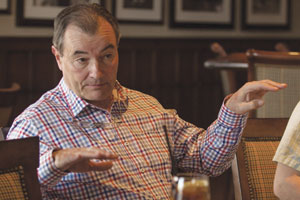
“That touches on the subject of remodeling. At the present time, you can buy a good house in a good location for 65 percent of the replacement cost. Then, you can update and renovate and still be in the house for less than building a new one.”
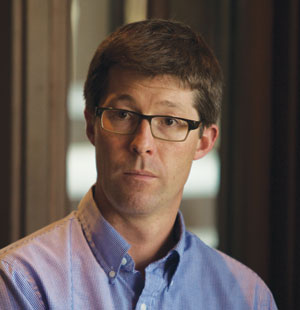
“People are more interested in the architectural design and the art of the design, and with that, people want the best house on the block—not the biggest. People are appreciating the lower energy, maintenance, and operation costs of a smaller home, even if they can afford more.”
Zimmerman: How is the home industry here different than before the downturn? What has changed?
David Lloyd: I’ll start first by saying that I have a great respect for those who have prospered through the last few years. Local contractors and craftsmen are now building a better house, using fewer resources, and employing efficient business systems. This change was born out of necessity, as the climate was very competitive.
Dennis Kavanagh: With the downturn, the bottom line became very important, if not most important. To react to that trend, we did across the board wage reductions and lowered the fee we charge for our profit and overhead, which we aggressively sought to lower. We also pressured our subs to do the same. Efficiency was the key word.”
Brian Poster: I have observed that since the start of the downturn, our suppliers are not carrying as much inventory. Their shelves are bare. If I need something, I may have to wait. The lead-time for materials is much greater, and with empty shelves, we have to plan way ahead.
Craig Johnson: Each one of us has a different perspective of the past eight years. I have noticed a generational change in the leadership of the construction sector. Younger builders are taking over lead roles since the downturn, and there has been a generational changing of the guard. Perhaps the younger builders were more willing to take risks. I think the downturn facilitated change and presented an opportunity to do things differently. With the downturn, I shifted to design-build as my business model.
Zimmerman: How have the prices of materials been affected?
Poster: Prices have increased for drywall and lumber. We are looking at newer materials to the market with more stable prices, and I would say the use of new types of material is up from the downturn.
Kavanagh: Commodities like lumber materials are controlled by supply and demand, and they are harvesting fewer trees, limiting supply. Select products like clear heart take a while between order and delivery, and they cost a whole lot more.
Johnson: Yes, Dennis is right. The majority of material costs didn’t go down, including the non-commodity products like appliances, furnaces, and fixtures, and if anything, many of these went up. Unfortunately, the downturn really drove down wages for skilled labor, and many left the workforce.
Zimmerman: What is the availability of skilled craftsmen in this area now? Will there be a sufficient number in the future? Will some skills be more in demand than others?
Poster: Today, there are enough, and in the near future. However, the young people are not going into the trades. Contrary to when many of us entered the construction trade, there aren’t ski instructors and ski patrolmen who do carpentry work, sheet metal, plumbing, or electrical in the summer.
Randy Schaeffer: No, there aren’t people going into tool and die making like my dad. What will happen when the old-timers are gone?
Poster: I think it is one of the biggest problems the construction industry will be facing down the road.
Lloyd: Yes, it is a real concern that the youth aren’t focusing on the trades. With less value in our culture for working with your hands coupled by the turbulent nature of the business, it will be difficult to recruit the craftsmen we need. Unless things change, we are looking at the last generation of skilled craftsmen.
Kavanagh: I agree with what you all are saying. I recently found out that there are no apprentices in the State plumbing program—no one in the pipeline. Plumbers make good money, but the next generation doesn’t seem to appreciate the value of a skilled labor career. I don’t know if that appreciation exists. However, Latinos may fill the vacuum.
Johnson: Due to the economic downturn, we lost a generation of employees. In the early 1980s, there was a government incentive program for on-the-job training that worked well. The workforce is aging, and it’s hard to read the future for how the void will be filled.
Zimmerman: It appears there is a design shift toward contemporary and modern. How does it change construction practices versus building in a mountain rustic style?
Kavanagh: We are observing a demographic shift because of the economy. There is a reduction in the cost of land, and younger people are coming into the area and they often want modern and contemporary homes. Unfortunately, with more out-of-town architects unfamiliar with the mountain climate, mistakes can be made. These designs require more dialogue between the builders and the architects.
Poster: I agree with what Dennis said. With these designs, tolerance is a millimeter to zero, and it requires substantial preplanning for lighting, board width, and stacking. Keeping a building project like this successful requires assembling the team right at the beginning: the architect, the builder, the interior designer, and the landscape architect.
Lloyd: It’s important to start out a team, and then the team can make adjustments. If a client starts out with the architect and bids out the construction on the architect’s final design, then it is already engineered. With a contractor on-board, it can be analyzed, and the detail packages can be redesigned for cost of construction. It can be value-engineered prior to final engineering and final design.
Kavanagh: Brian is absolutely right. The most successful projects start with a team at the outset.
Johnson: For me, by building both contemporary and rustic styles and mastering both styles, I have found a crossover that has brought more refinement to rustic and a more naturalistic feel to contemporary.
I find that is a bonus. However, my take on the out-of-town architects taking on local commissions is the local architects and builders may not be not fulfilling the desires of some of the higher end clients.
Zimmerman: And do you agree with Dennis about the shift to a younger demographic?
Lloyd: Yes, he’s right. There are more young families.
Johnson: Of course—more changing of the guard.
Dan Willett: When working with out-of-town architects who aren’t as familiar with the issues of a climate like Sun Valley, how willing are they to listen to you?”
Lloyd: If there is a real problem, we have a professional obligation to say something.
Kavanagh: At some point, that becomes a legal obligation.
Johnson: I have walked away from designs that I thought should not be built in this environment. One reason I shifted to design-build is that I retain design control. Clients benefit because the overall responsibility remains with me as the contractor.
Poster: I have worked on teams with out-of-town architects, and all three projects have been homeruns.
Zimmerman: Are you building smaller homes than say, seven years ago?
Kavanagh: The homes are smaller, and this is somewhat attributable to the Blaine County Build Smart Ordinance de facto limited size-by-performance requirements. A 14,000-square-foot home just won’t reach ordinance compliance, and a client wanting a home that size will go elsewhere.
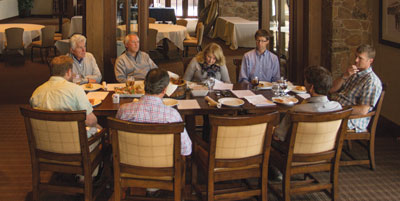
Poster: I just finished a streamside home that was 2,500-square-feet, and 6,000–8,000-square-feet are our meat and potatoes. I’ve never built a 15,000-square-foot home. Still the market is moving to smaller. I agree with Dennis regarding the Build Smart Ordinance. The code may have been well intentioned, but it is too far-reaching, not necessary, and hurting people.
Lloyd: People are more interested in the architectural design and the art of the design, and with that, people want the best house on the block—not the biggest. People are appreciating the lower energy, maintenance, and operation costs of a smaller home, even if they can afford more.
Johnson: Most people want to be socially responsible and build smaller, and in response, I have shifted to building 1,000–3,000-square-foot homes. While they may want to build a smaller scale, there is a desire to keep some of the luxury and design elements of larger homes. As a result, the smaller homes are better designed, and the levels of finishes are equal to the larger.
Zimmerman: Are financing and lending affecting how you build?
Lloyd: The local banks know exactly what we are doing, and we have had no issues and no problems. However, I have had an instance where clients ultimately purchased an existing home because the loan process for a new home appeared onerous to them.
Kavanagh: Banks are lending, but not on a speculative project. Take-out financing and mortgages are available.
Johnson: On the spec side, you are right Dennis. It is clear banks are not interested. Banks will lend, but they need quite a bit of equity because they fear they will not achieve an appraisal that supports the value. The lower end of the range is showing more health as the inventory diminishes, and prices are approaching the reproduction costs. As the market stabilizes, it will better support financing new construction.
Kavanagh: That touches on the subject of remodeling. At the present time, you can buy a good house in a good location for 65 percent of the replacement cost. Then, you can update and renovate and still be in the house for less than building a new one.
Zimmerman: If clients come up with a little extra in their budget, what products or features would you suggest adding?
Poster: It’s an individual decision for the clients, and I would leave it with them. But, if it were up to me, I would recommend prewiring and setting up for home automation for lights, blinds, security, and expanded functions.
Johnson: My favorites are electronics that turn on the lights and control the heat from the iPhone. But, touching on the green side, for the home I built for myself the feature that was really worth the expenditure was foam insulation. Because it retains an even heat so well, there are no hot spots to create ice dams on the roof. It really works.
Lloyd: The boring part of me would review their energy modeling and possibly suggest energy-saving products. The frivolous part of me would suggest small fun upgrades like concealed shower drains and the like. The masochistic part of me would let them accompany me to one of my builders’ shows where there are thousands of products, which they wouldn’t know existed, but once seeing them they would need to have them.
Kavanagh: I had a client in that position, and they opted for custom-cast hardware from Rocky Mountain Hardware. I’ll tell you, it was beautiful.
Zimmerman: Why should someone want to do your job? What do you enjoy?
Kavanagh: The people with whom we work are the movers and shakers in the country. We form great relationships, and this association is the best part of my job. Also, we are the dream fulfillers, and we get to see people move in and achieve that dream.
Lloyd: Someone should want my job because of the professional relationships made, which often turn into lasting social relationships. There is also a great satisfaction in creating something tangible. I can show friends and family who visit what I do, instead of telling them about my work. It is a fast-paced and ever-changing field in terms of materials, technology, and design. The challenge for me is similar to that of many others: balancing work and family.
Poster: It’s a dynamic industry. We build in one of the coolest places in the country. I call high-ranking clients on the East Coast, and they drop everything to take my call because they are excited to hear what’s going on here. Carpentry is one of the most rewarding careers I can think of, and the administration orchestrates the entire process and brings it all together. It’s a great career.
Johnson: My job has changed a lot since I started; it’s a lot more complex. The kinds of projects we get here are only built in a few areas of the country. They are exceptionally original in design and the demand for craftsmanship. With the high-caliber clientele base, client interaction continues to be the main source of my job satisfaction.
Kavanagh: The talent pool here is unmatched anywhere in the country, and a 100 percent of the second homes we build knock the doors off clients’ primary residences. Design is eclectic here and original, while other places have closed the door on innovation. Finally, we get to leave a great legacy. There is something standing that people use and enjoy.
With the time up, but significantly more to say, the group broke up commenting how valuable the exchange had been. Several piled in cars together to see their colleagues’ most recent projects.